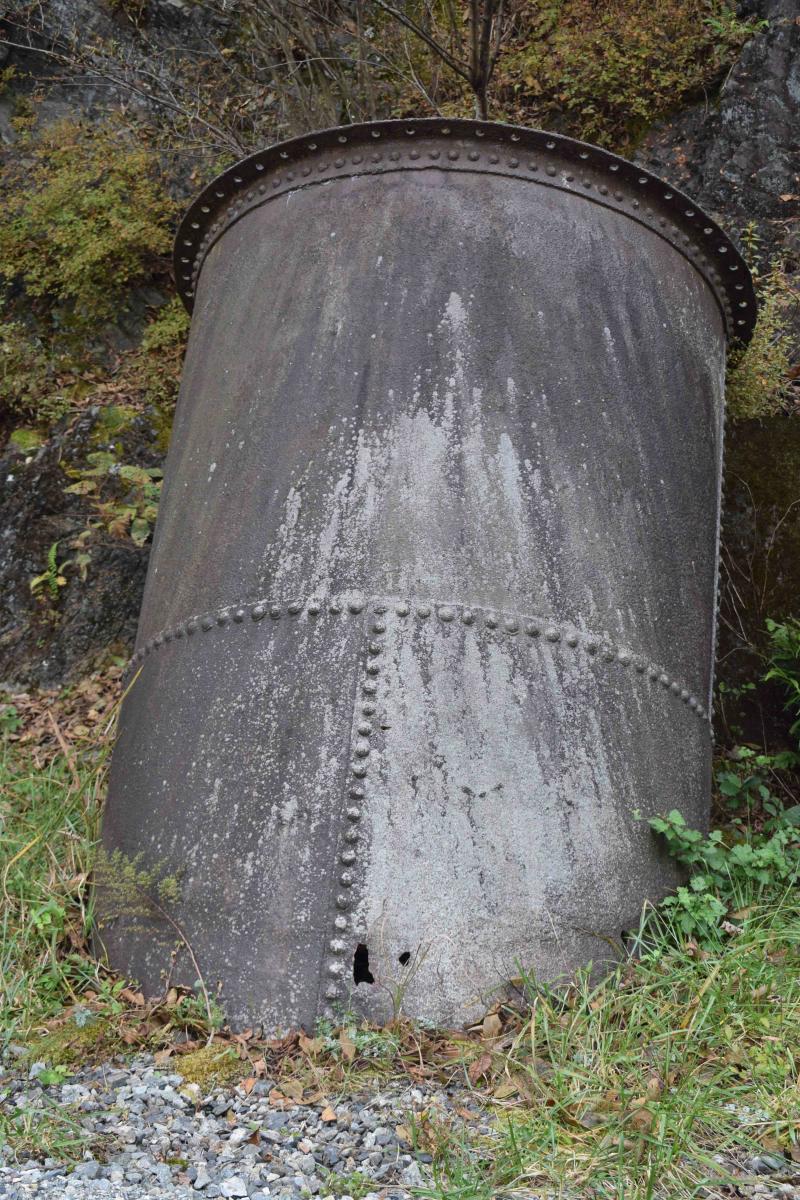Furukawa Ichibei (1832–1903) acquired Ashio Copper Mine on 30 December 1876. Through investment, the discovery of new deposits, technological innovation, and labor reform, Furukawa transformed the mines into one of Japan’s most productive facilities. His company eventually produced between 24 and 52.2 percent of Japan’s copper annually between 1883 and 1907. Ashio simultaneously became infamous for its smoke and water pollution, which caused damage to the areas around the mine and the communities living downstream. One factor central to Ashio’s productivity and its environmental effects was electrification, which allowed the mines to overcome certain environmental limitations and increase productivity.
During the nineteenth century, ventilation and flooding affected most mines in Japan and were particularly prominent at Ashio. Indeed, despite the discovery of a large deposit in 1881, production dropped due to flooding issues and poor ventilation, which made extracting the newly discovered ore difficult. In that year, the company began to install hand pumps in the mines, shifting away from the use of buckets to remove water. Improvements to ventilation were made in 1884 when vertical tunnels were dug, connecting different shafts for air circulation. In 1886, these connecting tunnels were expanded, and ventilators were introduced. At first, seven man-powered and water-powered ventilators were used; however, in the second half of 1886, these were replaced with steam-powered versions, as were the mine’s man-powered pumps. While the adoption of new technologies reduced the limitations created by flooding and poor ventilation, problems continued to exist deeper within the mines, meaning that neither issue was fully resolved. Furthermore, the steamification of the mining operations introduced new problems. By the mid-1880s, the mines required six times the amount of firewood and twelve times the charcoal that they had required in 1882, creating a shortage. The use of steam power also introduced smoke into the mines and thus, contrary to its aims, exacerbated ventilation issues. Murakami Yasumasa writes that when a boiler that was aimed at increasing the efficiency of the steam engine in the main pit began operating in 1886: “smoke exhaust did not discharge from the flue, and instead flowed into the workfaces at the top of the mine causing miners to collapse.”

Some of the ruins of the Matō Hydroelectric Power Plant. The photo shows remnants of piping through which water fell 31.8 meters to power the turbine.
Some of the ruins of the Matō Hydroelectric Power Plant. The photo shows remnants of piping through which water fell 31.8 meters to power the turbine.
© 2020 James Harry Morris. Used by Permission.
The copyright holder reserves, or holds for their own use, all the rights provided by copyright law, such as distribution, performance, and creation of derivative works.
Within this context, Furukawa turned to a new potential solution—the electrification of the mines. The mines began using electricity in blasting processes in 1886, and the following year, a thermal power station attached to the mines was opened. Simultaneously, Furukawa was engaging the German company Siemens to explore the possibility of introducing electricity into the mines on a wider scale. Wilhelm Heise and Otto Henneberg visited Ashio in 1886 and provided initial recommendations, and in 1887, Siemens dispatched Hermann Kessler to conduct a field survey. Furukawa placed his orders with the company in 1888. Work began on the Matō Hydroelectric Power Plant in September 1889 and was completed in December of the following year. The power station contained a 400-horsepower (hp) turbine, which drove three generators and was used for operating pumps, automating shaft hoisting, and lighting in the mines. Improvements to the plant in 1892 allowed for the electrification of drilling. That year, water (including hydroelectricity) supplied 1120 hp of the 1600 hp needed by the mines. The success of the Matō plant paved the way for the construction of other hydroelectric plants in the early 1890s—one in Tsūdō and three in Kodaki (the locations of other pits). Electricity was thereby introduced to all pits and adopted within the ore-dressing and smelting works.
The use of hydroelectricity resolved issues of flooding and eliminated the by-product of steamification—smoke pollution within the mines. It also reduced the mine’s dependence on firewood. If the mines were to rely solely on steam power, it would require 11,000 tons of firewood per year, costing approximately 22,000 yen to supply the 1600 hp needed in 1892. Hydroelectricity, however, provided a sustainable energy source with no fuel costs. Alongside other innovations taking place at the mines, electrification appears to have increased production. Between 1885 and 1890, Ashio produced a mean average of 4,180.5 tons per year; however, over the next five-year period from 1891 to 1896, this increased to an average of 5,969 tons. Indeed, according to Fred G. Notehelfer, the collective sum of Ashio’s technological advancements meant that by 1900, it was capable of producing “twice as much copper as its nearest national competitor, the Sumitomo’s Beshi Mine … with only 66 percent of Beshi’s labor force.”

Drills on display at the Nikkō Kinenkan (Nippon Mining Memorial Museum) in Hitachi City.
Drills on display at the Nikkō Kinenkan (Nippon Mining Memorial Museum) in Hitachi City.
© 2020 James Harry Morris. Used by permission.
The copyright holder reserves, or holds for their own use, all the rights provided by copyright law, such as distribution, performance, and creation of derivative works.
Although a likely unintended by-product of the introduction of hydroelectricity would have been a reduction in smoke pollution around Ashio as reliance on steam power and wood decreased, pollution was inextricably tied to copper production and therefore, contrary to our modern expectations, the increases in production ushered in by the electrification of the mines appear to have exacerbated pollution problems.
The Ashio Copper Mine was the first mine in Japan to successfully implement the use of hydroelectric power, allowing it to eliminate issues of flooding and poor ventilation, reduce reliance on firewood, and overcome other obstacles created by the adoption of steam power. This contributed to the mine’s increasing productivity but simultaneously exacerbated pollution issues. The (hydro)electrification of Ashio, therefore, points to the complicated linkages among energy, productivity, profit, and pollution, calling us to reflect on the possibilities, benefits, and costs of production and profit-driven sustainable energy.
How to cite
Morris, James. “Hydroelectric Power and the Ashio Copper Mine.” Environment & Society Portal, Arcadia (Summer 2023), no. 17. Rachel Carson Center for Environment and Society. doi:10.5282/rcc/9646
ISSN 2199-3408
Environment & Society Portal, Arcadia
 This work is licensed under a Creative Commons Attribution 4.0 International License.
This work is licensed under a Creative Commons Attribution 4.0 International License.
2023 James Morris
This refers only to the text and does not include any image rights.
Please click on an image to view its individual rights status.
- Itsukakai, ed. Furukawa Ichibei ō den [A biography of Furukuawa Ichibei]. Tokyo: Itsukakai, 1926.
- Hoshino, Yoshirō. History of Technological and Administrative Development in the Ashio Copper Mine. Tokyo: United Nations University, 1983.
- Murakami Yasumasa. Ashio dōzanshi [A history of Ashio copper mine]. Utsunomiya: Zuisōsha, 2006.
- Nihon keieishi kenkyūjo. Sōgyō 100 nenshi [A history of 100 years of business]. Tokyo: Furukawa Kōgyō Kabushiki Kaisha, 1976.
- Notehelfer, F. G. “Between Tradition and Modernity: Labor and the Ashio Copper Mine.” Monumenta Nipponica 39, no. 1 (Spring 1984): 11–24. doi:10.2307/2384478.
- Shoji, Kichiro, and Masuro Sugai. “The Ashio Copper Mine Pollution Case.” In Industrial Pollution in Japan, edited by Jun Ui, 18–63. Tokyo: United Nations University Press, 1992.
- Tochigi kenshi hensan iinkai. Tochigi kenshi, tsūshihen 8: Kingendai [A history of Tochigi Prefecture, historical overview, vol. 8, the modern era]. Vol. 3. Utsunomiya: Tochigiken, 1984.









